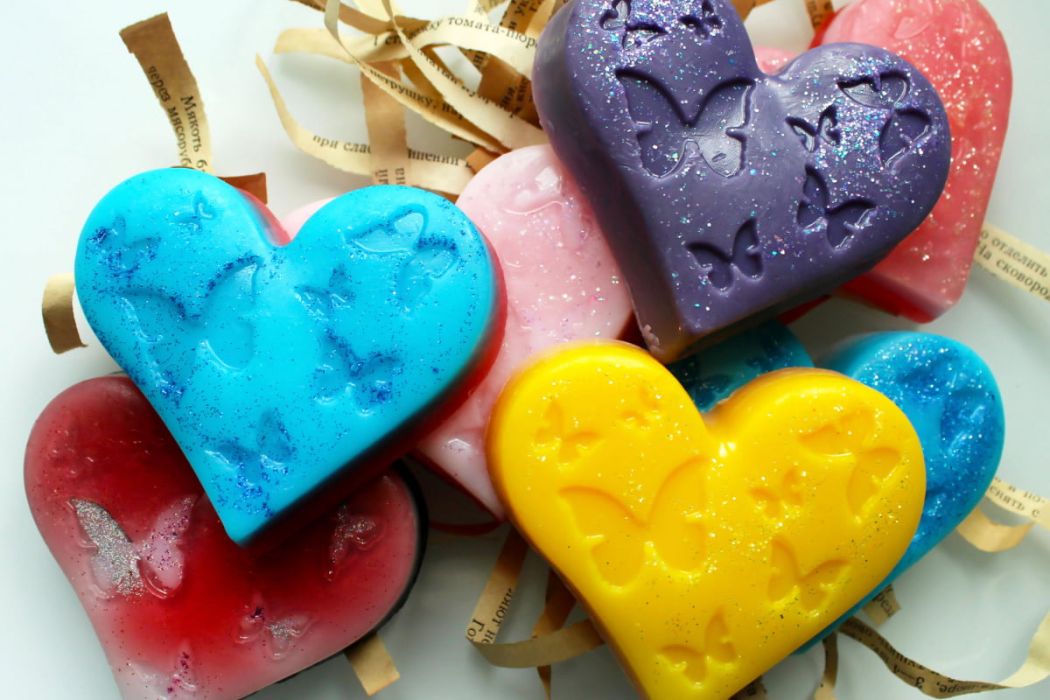Soap making is a wonderful hobby and a delight for the senses. It involves combining several key ingredients along with the color and fragrance of your choice, to create a magical brew. You’ll need to purchase and gather lye and a variety of oils, to make cold press soap.
Or, you can simply find a great melt and pour soap making kit, which will make things a lot easier.
The best kits come with everything you need (minus a supply or two depending on the kit), so all that you need to do is melt, customize, and pour! So, what should you look for in a melt and pour soap-making kit?
Learn more below!
Our Top 5 Recommended Kits
Best Seller
- ADORE THE REFRESHING SCENTS : of vanilla hazelnut, lavender, cherry blossom, and grapefruit mint. Make your own soap at home to enjoy the benefits of fragrance oils and scents while spending time with your family doing arts and crafts.
- SOAP MAKING SUPPLIES : includes 2 melt and pour shea butter soap base (2 lb), 4 fragrance oils, 4 liquid dyes (blue, yellow, green, red), 2 plastic soap molds, 1 mixing bowl, 2 strring sticks, 4 gift boxes and instruction manual.
Beginner Friendly Kit
- 🧼COMPLETE STARTER SET – Everything you need to create your own homemade soap is in this package. The package includes 2 lbs shea butter soap base, 2 silicone square containers, 6 liquid dyes, a glass measuring cup, a silicone stirring stick, 2 dry flowers, 12 homemade wraps labels tape a very detailed introduction.
- 🧼HOW SOAP WORKS – Soap contains fat-like substances known as amphiphiles, the soap molecules “compete” with the lipids. This is more or less how soap also removes normal dirt from the skin.
Editors Choice
- ALL THE SOAPMAKING SUPPLIES YOU NEED IN ONE KIT – Use our easy instructions to pour up to 8 bars of soap at a time using the included decorative molds, pipette, essential oils, and colorants
- 3 LBS ORGANIC GLYCERIN SOAP BASE for making up to 16 bars of soap at home Vegan, soy-free, hypoallergenic, gluten-free, kosher and non-comedogenic, this moisturizing soap base is great for all skin types!
- 3 ESSENTIAL OILS for natural fragrance: lavender, blood orange, and cedar, mix and match to create your own blends & 3 COLORANTS that can be combined to create a multitude of shades
Great Gift Option
- ♥ ALL THE SOAPMAKING SUPPLIES YOU NEED IN ONE KIT – Use our easy instructions to melt and pour soap base into the embossed soap molds in this easy soap making starter kit. Personalize each bar using 3 liquid dyes to tint your soap, 3 all natural essential oils, and included dried bonus flowers. A great DIY item for craft fairs and fundraisers, your audience will be sure to be impressed with these artisan bars of soap.
- ♥ 3 LBS COCOA BUTTER SOAP BASE – Crafts up to 16 unique soap bars. Our soap bases are made in the USA using only the finest ingredients. Kosher vegetable glycerine and food grade oils make these luxurious soap bars excellent for sensitive skin. They are made of soy-free, Non GMO components, and as our supplier puts it “As natural as we can make it.”
Junior Kit
- Soap Making Kits For Beginner Kids: Dazzle your daughter today with an exciting soap making kit for girls and boys. The B Me make your own soap kit for kids will help your little one unleash her imagination and creativity.
- Science Kits for Girls: The reusable silicone mold tray and 30 soap cubes will allow your girl to make a stem project and create up to 15 + fun-shaped soaps, layered soaps or encapsulated soaps with just one craft kit. – Make even more by using the smaller molds
- Perfect Slumber Party Activity: If you are looking for an engaging and educational sleepover, playdate, slumber birthday party game for girls, look no further than the B Me DIY soap making kit.
What is Melt and Pour Soap Making?
Melt and pour is one of the simplest ways that you can make soap. This being said, you can also customize it in a lot of ways; you can call each bar your own. Many will make melt and pour soap for personal use, or to sell.
They also make great gifts, because who wouldn’t appreciate a deliciously-scented, skin-loving soap bar?
Quality melt and pour soaps are much better than most other soap you would find at the store. This is because they are made with gentle, allergy-friendly ingredients, and they’re often all-natural. Many generic soap brands tend to have harsh chemicals that can irritate and dry out the skin.
This can increase the speed of aging, as it breaks down the skin’s resilience to wear. Not only that, but the skin will produce extra oil in an attempt to rehydrate, and this is almost sure to cause breakouts.
By replacing your generic storebought soap with homemade melt and pour, you can transform your skin, helping it become more moisturized, softer, and clearer than ever!
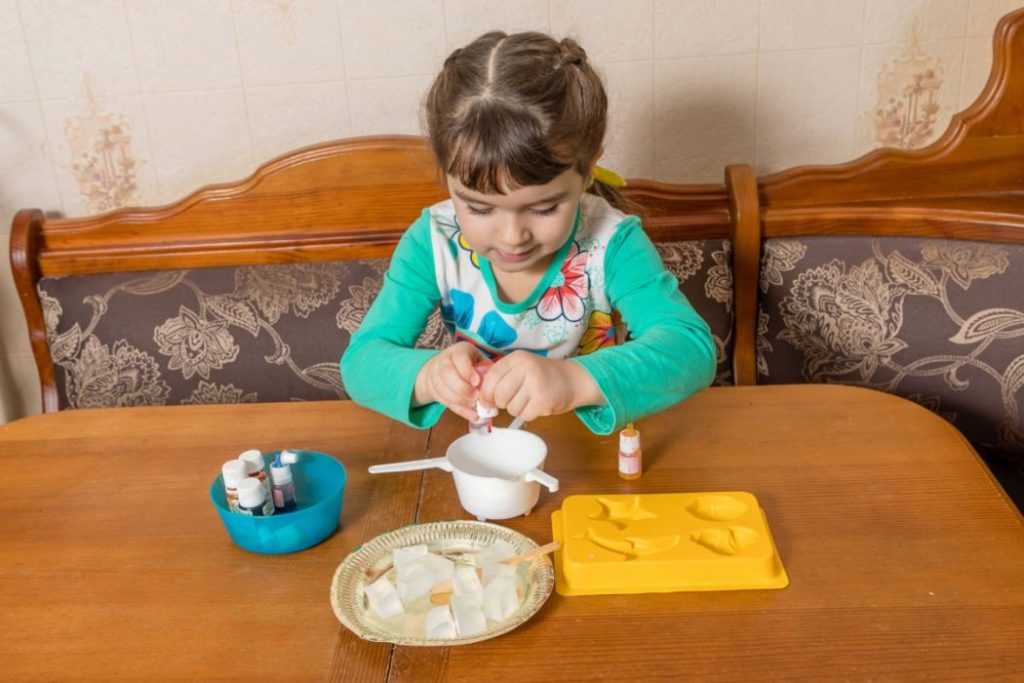
How Do You Make Melt and Pour Soap?
Melt and pour soap is usually made with a melt-and-pour soap kit. You can also melt any old soap block, however. These kits come with all of the most important ingredients: fragrances, molds, and of course, a block of clear or white unscented soap.
Many will also come with a pitcher, to help you pour. The steps to melt and pour soap making are:
- Melt. The first step to melt and pour soap is to melt some of your base soap. You can measure out how much you’d like to make first. Once it’s melted, move on to fragrance and color.
- Fragrance and color. This is arguably the most enjoyable part. Choose whatever colors and fragrances you think will go well together. You can choose a base color, and then loosely swirl in a couple of secondary ones, for a super easy, classic, ‘swirl’ soap bar!
- Pour. Once your soap is nice and colorful and smells heavenly, pour it into the mold. You’ll want to do this promptly, as the mixture will get thicker as it cools. You want it to pour easily, and to fill the molds just right.
- Cool. Allow your soap to cool overnight. If you’re using a long bar mold, it can be cut the next day.
- Cut. Cut out individual soap bars, if you’re using a long bar mold (if not, they’re done already!).
- Enjoy your top-quality, homemade soap bar.
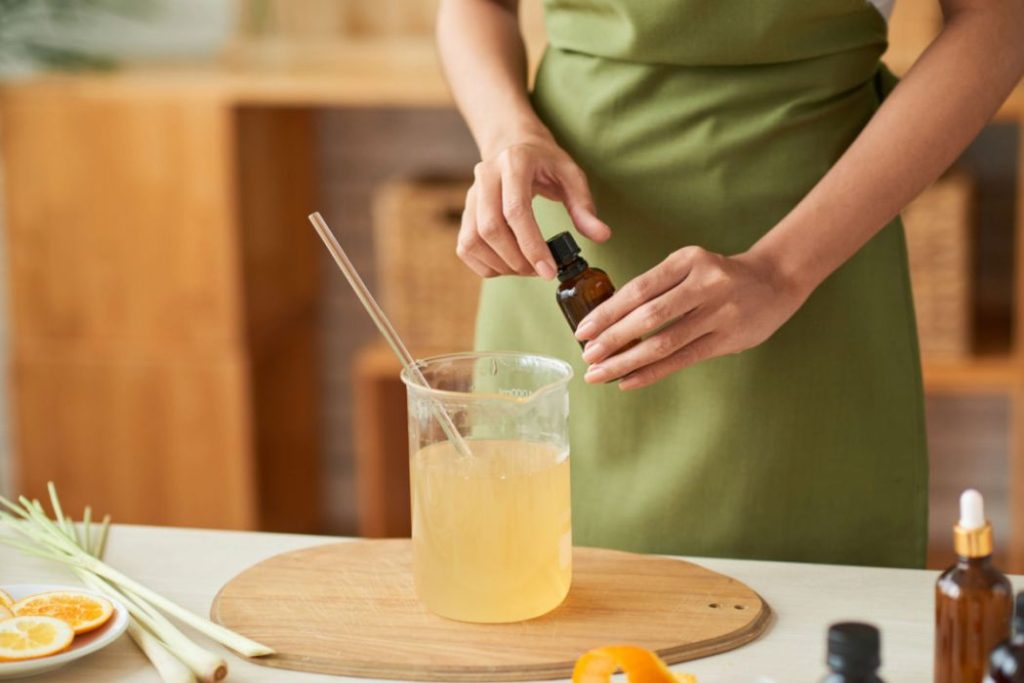
What Should You Look For in Melt and Pour Soap Making Kits?
As with any product, not all melt and pour soap-making kits are made the same. Some have higher quality ingredients. Others may come with low-quality, harsh fragrances.
These can cause skin irritation and even allergic reactions. Some types of soap are also more moisturizing and beneficial than others. So, you’ll need to know what to look for!
Soap Dye or Pigment Powder
If you’d like to make colored soap, you’ll probably want a kit with dye or pigment powder. You can also buy these separately, having them in a kit can simply make things easier.
Without soap dye or pigment powder, most soap kit soap is plain white, or clear. This leaves you with countless options and plenty of room for creativity. All that you need is a bit of color!
Natural Fragrances
When it comes to soap fragrances, there are a few things that you’ll want to consider. Allergies are the most important. To avoid any adverse reactions, you will want to make sure that the fragrances, especially, are top-quality, and as natural and skin-friendly as possible.
After all, you want a soothing rather than irritating soap bar.
A good thing to note is that the fragrance in a melt and pour soap-making kit will only be as good as the kit is. Excessively low-cost kits are likely to have harsh chemicals.
Not only that, but the fragrances tend to be rather unpleasant. For extra-gentle, heavenly-scented soap, it’s worth the extra buck!
If you opt to purchase fragrance separately, make sure that it works with melt and pour. Also, be aware that some fragrances can change your soap consistency or color. A soap-making kit with its own fragrances can take out the guesswork.
Read our complete Guide to soap making as a hobby here!
A Quality Base
The most significant part of any soap is the base. This will largely decide how the soap affects your skin. You will want a high-quality soap base, free of artificial colors or scents, or chemicals like alcohol.
The best soap bases will be composed of natural oils, such as shea butter, coconut oil, olive oil, and goat milk. These will nourish and hydrate the skin, even while cleansing it.
As a result, your skin will be more moisturized and radiant than ever (you’d be surprised what a difference unnatural low-quality soap vs natural high-quality soap can make).
Some bases may be colored already, so if you’re looking to customize your soap, make sure that the base is white or clear (most are).
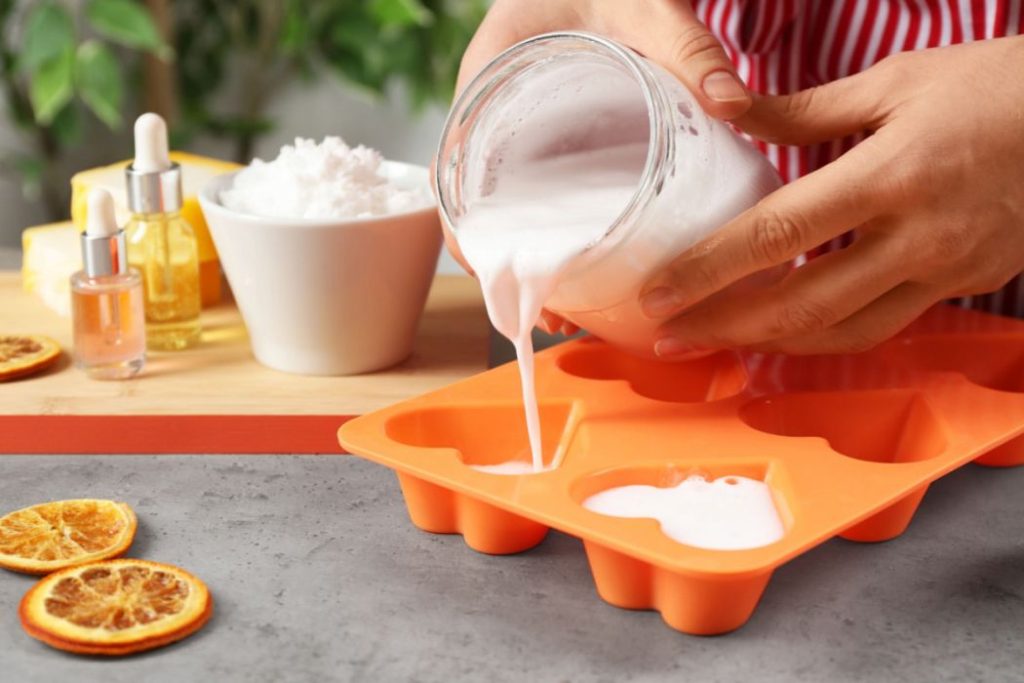
Molds
Any melt and pour soap-making kit worth its salt will come with a mold or two. This is essential. Most kits will have your classic bar mold, which is a slender block that you chop the soap from once it is finished and cooled.
There are also kits with whimsical shapes like hearts, flowers, etc. If you are a beginner, you may wish to start with the basic bar mold soap block.
Pitcher
As you can imagine, a key part of melt and pour soap making is how it is poured. A cup or measuring cup simply will not do, if you want a nice, neat soap bar. For this, you will need a pitcher.
The best kits will usually include these, but it doesn’t have to be a dealbreaker. Any pitcher that can handle the heat will do nicely. A pitcher will allow you to pour the melted soap into the mold precisely, for a flawless soap bar!
What Other Supplies Do You Need?
- Microwave. You’ll need a microwave for most methods of melt and pour.
- Microwaveable bowl. To melt the soap in, you’ll need a glass or plastic microwave-safe bowl.
- Stirring utensil. To stir the soap, fragrance, color, etc., you’ll need a suitable stirring utensil. A large spoon or spatula should do the trick!
- Cutting board. If you’re using a long soap bar block, and intend to chop the soap, you’ll want a cutting board to protect your table or counter.
- Knife or soap cutter. For cutting out soap blocks, a knife will do, but your best choice is a soap cutter (this makes the process seamless).
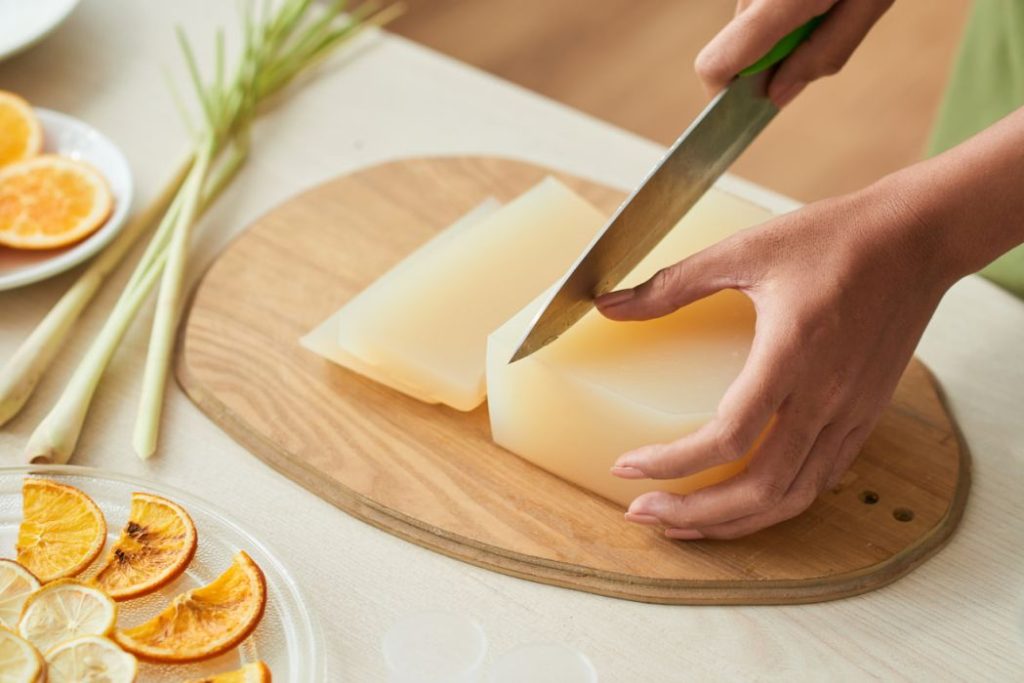
What Else Can You Add to Melt and Pour Soap?
If you think your melt and pour base could use a bit of a boost, feel free to enhance it with some natural oil. Try coconut oil, olive oil, avocado oil, or shea butter.
You can also add things like sprinkles, beeswax, and exfoliant (like salt) to customize the bars further!
Final Thoughts
Soap making is growing in popularity and has even become many hobbyist full-time living. Selling handmade soap bars on platforms like Esty and local markets. It’s not only fun but can actually become your career.
Start off with one of these beginner friendly kits and see if you like it as a hobby.
You can make great gifts for family and friends or simply us the environmentally friendly soap bars for your own personal use.

